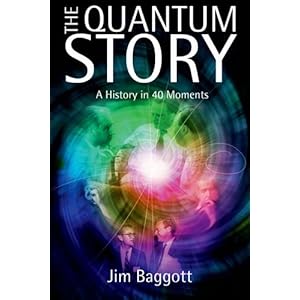
Cool article from Jim Baggott at the OUP Blog. He concludes with the position that has launched a whole market of New Age Physics crap:
Another anthropocentric vision of reality - and I'm not buying it (yet).Without a measuring device to record it, there is a sense in which the recognisable properties of quantum particles such as electrons do not exist, just as the falling tree makes no sound at all.
‘Reality is merely an illusion,’ Einstein once admitted, ‘albeit a very persistent one.’
Jim Baggott’s new book is The Quantum Story: A History in 40 Moments (hitting shelves in April). He has also published many other books, including Beyond Measure: Modern Physics, Philosophy and the Meaning of Quantum Theory and A Beginner’s Guide to Reality.
Read the whole article.Quantum Theory: If a tree falls in forest…
By Jim Baggott
If a tree falls in the forest, and there’s nobody around to hear, does it make a sound?
For centuries philosophers have been teasing our intellects with such questions. Of course, the answer depends on how we choose to interpret the use of the word ‘sound’. If by sound we mean compressions and rarefactions in the air which result from the physical disturbances caused by the falling tree and which propagate through the air with audio frequencies, then we might not hesitate to answer in the affirmative.
Here the word ‘sound’ is used to describe a physical phenomenon – the wave disturbance. But sound is also a human experience, the result of physical signals delivered by human sense organs which are synthesized in the mind as a form of perception.
Now, to a large extent, we can interpret the actions of human sense organs in much the same way we interpret mechanical measuring devices. The human auditory apparatus simply translates one set of physical phenomena into another, leading eventually to stimulation of those parts of the brain cortex responsible for the perception of sound. It is here that the distinction comes. Everything to this point is explicable in terms of physics and chemistry, but the process by which we turn electrical signals in the brain into human perception and experience in the mind remains, at present, unfathomable.
Philosophers have long argued that sound, colour, taste, smell and touch are all secondary qualities which exist only in our minds. We have no basis for our common-sense assumption that these secondary qualities reflect or represent reality as it really is. So, if we interpret the word ‘sound’ to mean a human experience rather than a physical phenomenon, then when there is nobody around there is a sense in which the falling tree makes no sound at all.
This business about the distinction between ‘things-in-themselves’ and ‘things-as-they-appear’ has troubled philosophers for as long as the subject has existed, but what does it have to do with modern physics, specifically the story of quantum theory? In fact, such questions have dogged the theory almost from the moment of its inception in the 1920s. Ever since it was discovered that atomic and sub-atomic particles exhibit both localised, particle-like properties and delocalised, wave-like properties physicists have become ravelled in a debate about what we can and can’t know about the ‘true’ nature of physical reality.
No comments:
Post a Comment